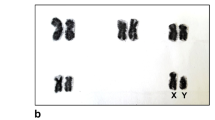Abstract
Metaphase chromosomes from neuroblasts of strains from both laboratory stocks and natural populations of D. serido, D. meridionalis, D. borborema and D. buzzatii have been studied using colcemid pretreatment, and air-drying followed by Giemsa staining. The two latter species both show a uniform ‘basic’ metaphase karyotype. D. serido and D. meridionalis, on the other hand, both include a number of different, geographically distinct, metaphase karyotypes involving differences in the major blocks of constitutive heterochromatin present on the sex chromosomes and/or the 6th chromosome (microchromosome). These chromosomal differences are largely due to the acquisition of extra heterochromatin though pericentric inversions appear to be responsible for some of the Y-chromosome variants in D. serido. Moreover, the cytological evidence demonstrates that populations of both species are far from continuous in distribution. The extent to which such cytological differences reflect the existence of subspecific or specific complexes with minimal morphological differentiation is under investigation.
Similar content being viewed by others
References
Ab'Saber, A. N., 1977. Espacos ocupados pela expansao dos climas secos na America do Sul, por ocasiao dos periodos glaciais quaternarios, Paleoclimas (Inst. Geogr. Univ. S Paulo) 3: 1–19.
Baimai, V., 1977. Chromosomal polymorphisms of constitutive heterochromatin and inversion in Drosophila. Genetics 85: 85–93.
Baimai, V. & Chumchong, C., 1980. Karyotype variation and geographic distribution of the three sibling species of the Drosophila kikkawai complex. Genetica 54: 113–120.
Bizzo, N. M. V. & Sene, F. M., 1982. Studies on the natural populations of Drosophila from Peruibe (SP), Brazil, Revta bras. Biol. (in press).
Bonaccorsi, S., Santini, G., Gatti, M., Pimpinelli, S. & Coluzzi, M., 1980. Intra-specific polymorphism of sex chromosome heterochromatin in two species of the Anopheles gambiae complex. Chromosoma 76: 57–64.
Brown, S. W., 1966. Heterochromatin. Science 151: 417–425.
Carson, H. L., 1968. The population flush and its genetic consequences. In: Population biology and evolution, R. C. Lewontin, ed., Syracuse University Press, pp. 123–137.
Carson, H. L., 1971. Speciation and founder principle. Stadler Genetics Symposia 3: 51–70.
John, B. & King, M., 1977. Heterochromatin variation in Cryptobothrus chrysophorus. I. Chromosome differentiation in natural populations. Chromosoma 64: 219–239.
Pathak, S., Hsu, T. C. & Arrighi, F. E., 1973. Chromosomes of Peromyscus (Rodentia, Cricetidae). IV The role of heterochromatin in karyotypic evolution. Cytogenet. Cell Genet. 12: 315–326.
Patterson, J. T. & Stone, W. S., 1952. Evolution in the genus Drosophila. Macmillan, New York.
Pereira, M. A. Q. R., C. R. Vilela and F. M. Sene, 1982. Notes on breeding and feeding sites of some species of the repleta group of the genus Drosophila (Diptera, Drosophilidae). Ciênc. Cult., S Paulo (in press).
Schmid, W., 1967. Heterochromatin in mammals. Arch. J. Klaus-Stift. VererbForsch. 42: 1–60.
Shaw, D. O., 1976. Population cytogenetics of the genus Caledia (Orthoptera, Acridinae). I. Inter-and intra-specific karyotype diversity. Chromosoma 54: 221–243.
Vilela, C. R. and F. M. Sene, 1977. Two new neotropical species of the ‘repleta group’ of the genus Drosophila (Diptera, Drosophilidae). Papéis Dep. Zool. S Paulo 30(20): 295–299.
Vilela, C. R., F. M. Sene & M. A. Q. R. Pereira, 1980. On the Drosophila fauna of Chaco and East Slopes of the Andes in Argentina. Revta bras. Biol. 40(4): 837–841.
Vilela, C. R., M. A. Q. R. Pereira & F. M. Sene, 1982. Preliminary data on the geographical distribution of Drosophila species within morphoclimatic domains of Brazil: II. The repleta group. Cienc. Cult. S Paulo (in press).
Vosa, C. G., 1976. Heterochromatin banding systems in Allium. II. Heterochromatin variation in species of the paniculatum group. Chromosoma 57: 119–133.
Wasserman, M., 1954. Cytological studies of the repleta group. Univ. Tex. Publs. 5422: 130–152.
Wasserman, M., 1960. Cytological and phylogenetic relationships in the repleta group of the genus Drosophila. Proc. natn. Acad. Sci. U.S.A. 46: 842–859.
Wasserman, M., 1962a. Cytological studies of the repleta group of the genus Drosophila. III. The mercatorum subgroup. Univ. Tex. Publs 6205: 63–72.
Wasserman, M., 1962b. Cytological studies of the repleta group of the genus Drosophila. IV. The hydei subgroup. Univ. Tex. Publs 6205: 73–84.
Wasserman, M., 1962c. Cytological studies of the repleta group of the genus Drosophial. V. The mulleri subgroup. Univ. Tex. Publs 6205: 85–118.
Wasserman, M., 1962d. Cytological studies of the repleta group of the genus Drosophila. VI. The fasciola subgroup. Univ. Tex. Publ., 6205: 119–134.
Wasserman, M., 1963. Cytological and phylogeny of Drosophila. Am. Nat. 97: 333–352.
Wasserman, M., 1981. The repleta species group. In: The generics and biology of Drosophila, vol. 3, M. Ashburner, H. L. Carson & J. N. Thompson Jr. (Eds), Academic Press, London (in press).
Wasserman, M. & Wilson, F. D., 1957. Further studies on the repleta group. Univ. Tex. Publs 5721: 132–156.
Wharton, L. T., 1942. Analysis of the repleta group of Drosophila. Univ. Tex. Publs. 4228: 23–52.
Wharton, L. T., 1943. Analysis of the metaphase and salivary chromosome morphology within the genus Drosophila. Univ. Tex. Publs. 4313: 281–327.
Wheeler, M. R., 1970. Family Drosophilidae. In: Museum de Zoologia, Universidade de São Paulo, A Catalogue of the Diptere of the Americas South of the United States 79: 1–65.
White, M. J. D., 1973. Animal cytology and evolution. 3rd ed., Cambridge Univ. Press, Cambridge.
Yosida, T. H. & Sagai, T., 1975. Variation of C-bands in several subspecies of Rattus rattus. Chromosoma 50: 283–300.
Author information
Authors and Affiliations
Rights and permissions
About this article
Cite this article
Baimal, V., Sene, F.M. & Pereira, M.A.O.R. Heterochromatin and karyotypic differentiation of some neotropical cactus-breeding species of the Drosophila repleta species group. Genetica 60, 81–92 (1983). https://doi.org/10.1007/BF00127494
Received:
Accepted:
Issue Date:
DOI: https://doi.org/10.1007/BF00127494




